FIND MISSING ANGLES IN PARALLELOGRAM
Subscribe to our ▶️ YouTube channel 🔴 for the latest videos, updates, and tips.
Consecutive Angles in Parallelogram
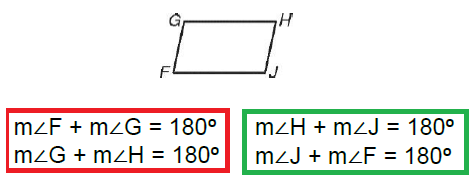
Opposite Angles in Parallelogram

Find the value of x that will make the shape a parallelogram and give a reason to support your answer.
Problem 1 :
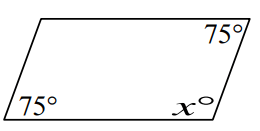
Solution :
Reason : Consecutive angles add upto 180.
75 + x = 180
x = 180 - 75
x = 105
Problem 2 :
Solve for x in the parallelogram given below.
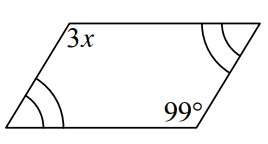
Solution :
Reason : Opposite angles are equal.
3x = 99
x = 99/3
x = 33
Problem 3 :
Solve for x in the parallelogram given below.
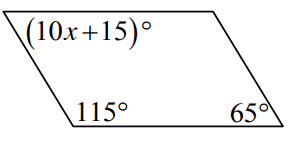
Solution :
Reason : Opposite angles are equal.
10x + 15 = 65
10x = 65 - 15
10x = 50
x = 50/10
x = 5
Problem 4 :
Solve for x and y in the parallelogram given below.
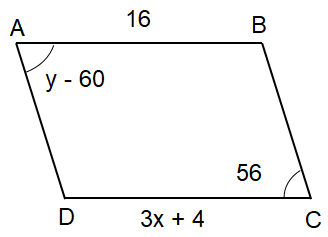
Solution :
Reason : Opposite angles are equal.
y - 60 = 56
y = 56 + 60
y = 116
Reason : Opposite sides are equal.
3x + 4 = 16
3x = 12
x = 12/3
x = 4
Problem 5 :
Use the diagram of parallelogram ABCD below to answer the questions.
|
1) Find CD 2) Find m∠ADB 3) Find m ∠BDC |
4) Find AC 5) Find m∠DCB 6) Find BE |
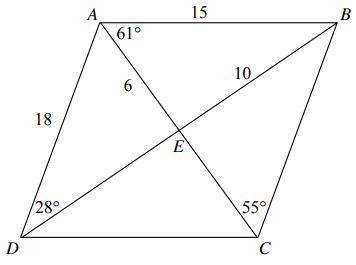
Solution :
1) CD = AB (Opposite sides)
CD = 15
2) ∠ADB = 28
3) ∠BDC :
In triangle ABC,
|
∠BAC+∠ACB+∠ABC = 180 61 + 55 + ∠ABC = 180 116 + ∠ABC = 180 ∠ABC = 180 - 116 ∠ABC = 64 |
∠ABC = ∠ABD + ∠DBC 64 = ∠ABD + 28 ∠ABD = 64 - 28 ∠ABD = 36 ∠BDC = 36 |
4) AC = 2AE ==> 2(6) ==> 12
5) ∠DCB = ∠DCA + ∠ACB
∠DCB = 61 + 55
∠DCB = 116
6) BE = 10
Problem 6 :
Solve for x and y in the parallelogram given below.
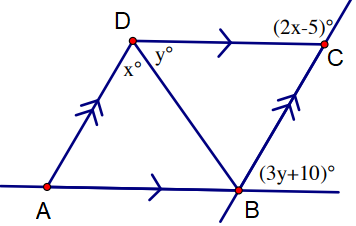
Solution :
AB and DC are parallel and DB is transversal.
∠DBC = x
In triangle DBC,
y + x = 2x - 5
x - 2x + y = -5
-x + y = -5 ------(1)
x + y + 3y + 10 = 180
x + 4y = 170 ------(2)
|
(1) + (2) -x + x + y + 4y = -5 + 170 5y = 165 y = 165/5 y = 33 |
Applying y = 33, we get -x + 33 = -5 -x = -5 - 33 -x = -38 x = 38 |
Problem 7 :
Find the missing value in each of the following parallelogram.
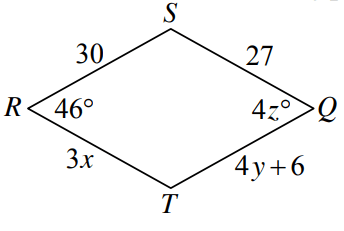
Solution :
|
∠SRT = ∠SQT 46 = 4z z = 46/4 z = 11.5 |
RT = SQ 3x = 27 x = 27/3 x = 9 |
TQ = RS 4y + 6 = 30 4y = 30 - 6 4y = 24 y = 24/4 y = 6 |
Problem 8 :
Given that quadrilateral ABCD is a parallelogram find the values of x and y.
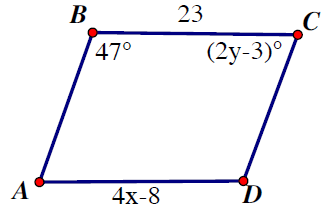
Solution :
Reasons : Sum of consecutive interior angles = 180
Opposite sides are equal.
|
47 + 2y - 3 = 180 2y + 44 = 180 2y = 180 - 44 2y = 136 y = 136/2 y = 68 |
4x - 8 = 23 4x = 23 + 8 4x = 31 x = 31/4 |
Problem 9 :
Find the length of CF. AB = 12, AD = 10, CE = 8.
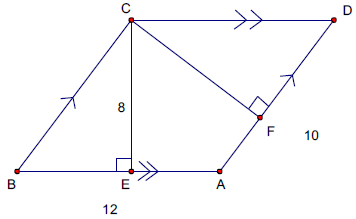
Solution :
In the parallelogram ABCD, CE and CF are perpendiculars.
Area of parallelogram = base x height
AB x CE = AD x CF
12 x 8 = 10 x CF
96 = 10 CF
CF = 96/10
CF = 9.6
Problem 10 :
Find the value of x that will make the shape a parallelogram and give a reason to support your answer.
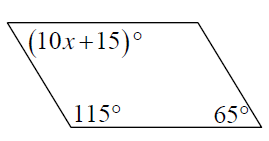
Solution :
Sum of consecutive interior angles = 180
10x + 15 + 115 = 180
10x + 130 = 180
10x = 180 - 130
10x = 50
x = 50/10
x = 5
Subscribe to our ▶️ YouTube channel 🔴 for the latest videos, updates, and tips.
Recent Articles
-
Finding Range of Values Inequality Problems
May 21, 24 08:51 PM
Finding Range of Values Inequality Problems -
Solving Two Step Inequality Word Problems
May 21, 24 08:51 AM
Solving Two Step Inequality Word Problems -
Exponential Function Context and Data Modeling
May 20, 24 10:45 PM
Exponential Function Context and Data Modeling